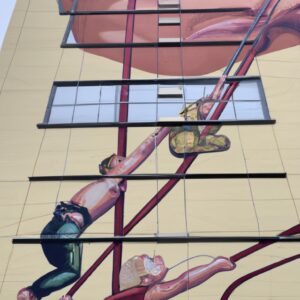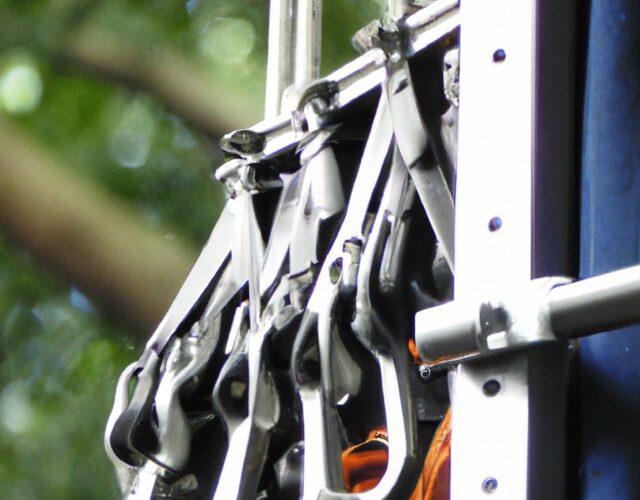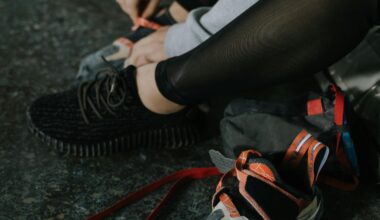Tower Climbing Gear is the best way to ensure safety and efficiency when ascending towering structures. Tower climbing is a unique type of activity that requires specific materials and equipment to ensure the safety of workers. Tower climbing involves ascending and descending towers while performing necessary maintenance, repairs, or inspections. It is a skill that is important in many industries such as telecommunications, power transmission, wind energy, and other related fields. To be successful and safe while tower climbing it is essential to understand the type of gear needed.
Whether you’re a novice or experienced climber, there are certain items of gear that must be used. This guide will cover the types of gear required for tower climbing while also providing information on what protective clothing and training is necessary. To put it simply, being properly equipped with the right materials and following the proper training protocols is the key to a successful and safe tower climbing experience.

Choosing the Right Gear
When it comes to tower climbing safety, it’s important to know the right gear to use. In this section, we’ll discuss the types of gear needed for tower climbing and their importance to ensure a safe climb.
Harnesses are essential when it comes to tower climbing, as they provide support and security when climbing up and down the tower. There are several different types of harnesses available, so it’s important to choose the one that is best suited for the job at hand. It’s also important to make sure the harness fits properly and meets all safety requirements.
Lifelines should be worn to provide an extra layer of safety during a climb. They are typically connected to a harness and fed through a carabiner before being connected securely to an anchor point. The lifeline should be long enough to allow for a comfortable climb, but not too long to become tangled.
Lanyards are another important piece of safety gear, as they act as a connection between the climber and the anchor points. They are typically made from a webbing material and feature a variety of attachments, such as carabiners and other hardware, to allow for easy connection to anchors.
Other essential gear for tower climbing includes helmets, gloves, protective eyewear, and flame retardant clothing. The helmet should fit snugly and be able to absorb impacts from falling objects or debris. Gloves should fit securely and provide good grip when gripping the rungs of the tower. Protective eyewear is a must to protect from any flying debris or sparks created by welding. Lastly, flame retardant clothing is necessary to protect from any burning debris or hazardous materials.
Choosing the right gear for tower climbing is important for both personal safety and the safety of those around you. Making sure the right gear is chosen and used correctly is an essential part of making sure a safe climb can be achieved.
Protective Gear
When it comes to tower climbing, safety is of utmost importance and the right protective gear can mean the difference between life and death. All tower climbers, as well as anyone working on or near a tower, must wear appropriate clothing, eyewear, gloves, and helmets. Flame retardant (FR) clothing is a must, but depending on the location, weather, and type of work being done, additional clothing may be required.

Helmets are essential to protect your head from falling objects and to secure any additional lighting or communication equipment you may need while on the tower. Going a step further, some tower climbers opt for full-face helmets with face shields for added protection. Gloves should always be worn to ensure a firm grip on ladders and other equipment. Goggles, sunglasses or even prescription eyewear can help protect against debris and wind, as well as keep your vision clear in all light conditions.
The type of clothing needed will depend on the environment and the job at hand. In addition to FR-rated material, layers of clothing can provide extra insulation and protection from the elements. Make sure to choose high-quality pieces that are designed for tough conditions. Boots are also important and should be non-skid and steel-toed for enhanced safety. For very long jobs, some tower climbers may choose to carry additional clothing or blankets to change into.
Training Requirements
When it comes to being a tower climber, safety is paramount. As such, anyone wanting to climb towers must have the necessary training and certifications for the job.
In order to ensure a safe and successful tower climbing experience, proper training is essential. Before even considering a climb, it’s important to have a good understanding of the different types of equipment used, the hazards associated with tower climbing, and the basic safety protocols and procedures.
There are a few certifications that one should consider when pursuing a career as a tower climber. Having an OSHA 10-hour construction safety certification is highly recommended, as this provides knowledge of safety regulations and requirements that should be followed. Additionally, some employers may ask for a special OSHA 30-hour construction course. It is also beneficial to have First Aid/CPR certification.
Furthermore, there are specific tower climbing training programs that are available. These courses cover the basics of proper climbing techniques and safety procedures. This includes how to securely connect to the tower, how to properly inspect and use equipment, and safety protocols for working with high voltage electrical components.
Having additional certifications or qualifications, such as a diploma in structural engineering, can be beneficial as well. This will give an individual a better understanding of the structure of towers and the design of the various components. It will also help them in troubleshooting any technical issues.
No matter what certifications and qualifications one has, it’s important to stay up to date on the latest safety protocols and regulations. This will ensure that all climbs are done in a safe manner and all potential hazards are avoided.
Assembling & Dismantling Tower Climbing Systems
Tower climbing gear is essential for those who climb cell towers and telecom towers for maintenance, construction, and inspection. Proper installation of the gear is essential for safety and the successful completion of the project. When assembling and dismantling the gear, it is important to follow these steps.
The first step is to connect the anchor points, an essential part of tower climbing. Anchor points may include bolts as well as brackets or other metal structures. For most rigs, at least two anchor points are required. Each anchor point must be strong enough to support the weight of the climber, the gear, and any other equipment used to complete the job.
The next step is to connect the rigging, a rope, cable, or chain used to attach the gear along the way. Rigging comes in a variety of sizes and types and must be rated for the purpose it is used. For example, if the climber needs to carry tools, then the rigging must be rated accordingly.
The next step is to build the communication system. This is necessary to ensure that the climber and ground crew are in constant communication throughout the climb. The communication system must cover the height of the tower and be able to handle any potential obstructions such as trees or buildings.
Finally, the gear must be properly installed, tested, and inspected for any damages before each use. This includes visual inspections of all parts of the gear and testing for structural integrity and sturdiness. Once the installation is complete, the user should be sure to practice proper techniques for ascending and descending the tower.
By following these steps, climbers can ensure that their climbing gear is in good working order and ready for the job ahead. With the right skills and knowledge, they can climb with confidence and safety.
Climbing Techniques
Tower climbers must maintain a safe, efficient and effective approach when climbing towers. It is important to understand the techniques involved in tower climbing, as these techniques will help keep climbers safe and allow them to ascend or descend with ease. There are several techniques used when climbing towers, including ascending, descending, hand-foot climbing, rappelling and top-viewing.
Ascending & Descending
Ascending is the process of moving up a tower, while descending is moving down a tower. The most common way to ascend is with the use of ladders or stairs, while descending is typically done via rappelling. It is important to use caution when ascending or descending, as slipping and falling can occur. It is also important to ensure all safety equipment is used properly.

Hand-Foot Climbing
Hand-foot climbing is a technique used when climbing towers without the use of ladders or stairs. This involves using hands and feet to climb the tower directly. It is a relatively risky technique and should only be attempted when other options are not available. It is important to always wear protective clothing and equipment, such as gloves and helmets, while hand-foot climbing.
Rappelling
Rappelling is another technique used to safely and quickly descend from a tower. It involves using a rope and a harness to lower oneself down. Again, it is important to use protective clothing and equipment when rappelling. It is also important to ensure the rope is secured properly and that the climber is able to control their descent.
Top-Viewing
Top-viewing is a technique used when climbers want to view the structure from the top of the tower. This can be done with the assistance of a remote controlled drone or an aerial lift. This technique is usually not done by individuals, but rather by groups or teams of professionals. It is important to ensure all safety protocols are followed, as this technique can be dangerous.
Climbing towers can be a dangerous activity, so it is important to know and understand the techniques involved. By understanding these techniques, climbers can remain safe while navigating their way up and down towers. It is also important to use safety equipment and protective clothing when ascending and descending, as well as during hand-foot climbing and rappelling. Lastly, top-viewing should only be done under the direction of experienced professionals.
Final Considerations for Tower Climbing
Climbing towers is a safe and rewarding activity, as long as the proper preparation and precautions are taken. Before embarking on any tower climbing project, make sure to thoroughly inspect all gear and equipment for any signs of wear or damage. Additionally, it’s important to consider the weather conditions before climbing a tower, as strong winds or thunderstorms can create dangerous working conditions.
General safety protocol dictates that the climber should always take a partner when going up a tower. A climber should also always stay attached to the tower while they’re working, even if they need to reach or adjust something outside of their reach. Only an experienced climber with specialized rigging experience should attempt to work on communication lines or other intricate projects on a tower.
For anyone working near a tower, it’s essential to be aware of their surroundings and potential hazards, such as electrical lines, communication cables and high-voltage powerlines. All personnel must take proper protective measures while they’re working around a tower, including wearing flame-resistant clothing, goggles and hard hats to prevent injury.
In order to ensure a safe and successful tower climbing experience, take the time to plan, prepare, and review all of your equipment and safety protocols. Doing this will help to ensure a productive and safe tower climbing experience for everyone involved.
Conclusion
Tower climbing is an essential component of many industries, often requiring the highest levels of safety and security. As such, it is important for those who are engaging in tower climbing to have the right gear, protective clothing, and training qualifications. This article has gone through the necessary steps to properly assemble and climb towers, as well as final considerations for a successful experience.
The most important takeaway from this article is understanding that tower climbing is a high-risk activity that requires specific equipment and preparation. From choosing the right gear to assembling the systems correctly, tower climbing is a complex and challenging task. However, with the right equipment and training, climbers can enjoy a safe and rewarding experience.
If you would like to learn more about tower climbing and its specific requirements, there are numerous resources available online. Additionally, there are many organizations and courses dedicated to helping people understand how to safely and correctly climb towers.
Tower Climbing Gear – FAQs
What is tower climbing?
Tower climbing is the act of scaling a tower or other tall structure for various purposes, such as maintenance, inspection, or installation of equipment.
Why is safety so important in tower climbing?
Safety is crucial in tower climbing because it involves working at great heights with potential hazards such as falls, electrical shocks, and equipment failure. Proper safety measures can prevent injuries and fatalities.
What kind of climbing gear is required for tower climbing?
Tower climbing gear such as harnesses, lanyards, ropes, carabiners, and helmets are required for safe climbing. Make sure to use high-quality gear that meets industry standards and proper care and maintenance.
How can I choose the right gear for tower climbing?
Choose a brand with a wide range of tower climbing gear and a commitment to safety. Look for gear that meets ANSI and OSHA standards, and offers features such as adjustability, comfortable padding, and fall arrest systems.
What is a positioning lanyard?
A positioning lanyard is a device used to keep a tower climber in a fixed position while working. It is designed to prevent falls and allows a worker to easily move from one position to another.
Why is fall protection equipment necessary in tower climbing?
Fall protection equipment is necessary to prevent falls and ensure the safety of tower climbers. Items such as lanyards, safety equipment, and fall arrest systems help to protect workers from falls and minimize the risk of injury.
What are some of the most reputable brands in tower climbing gear?
Brands such as Petzl and Elk River are well-known in the tower climbing industry and are known for their high-quality and safe equipment.
What should I look for when shopping for tower climbing gear?
When browsing for tower climbing gear, make sure to look for features such as durable design, proper fit, and easy-to-use tools. Additionally, select gear that is compatible with the type of work you will be doing.
Is training required for tower climbing?
Yes, professional tower climbers require specialized training to ensure that they are knowledgeable about the risks associated with tower climbing and how to prevent injuries.



